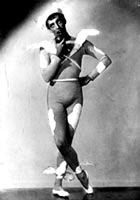Broadway big shot
American director and choreographer the late Jerome Robbins is regarded by many as a genius of 20th century dance, and Nick Smurthwaite agrees

Traditionally, showbiz biographies tend to be text-heavy plods through some illustrious career or other, with an occasional clump of black-and-white photographs to relieve the monotony. Christine Conrad’s book about Jerome Robbins, the great American director and choreographer (On The Town, West Side Story, The King and I and so on), who died in 1998, is markedly different.
As you’d expect from such a steep cover price, this is a very classy production. Booth-Clibborn has once more tapped into popular culture with a cult figure and Pentagram’s design is as stylish and innovative as the man himself. Alternating pages of white text with pages in pastel grey and yellow, the designers have succeeded in making optimum use of Conrad’s somewhat scrappy narrative.
Conrad, a long-time friend of Robbins, opts for telling his story mostly through quotes from press interviews, and extracts from his own handwritten journals, with an occasional linking piece written by her. The illustrative stuff from his journals – delicate watercolours made in Long Island, and colourful collages of pressed flowers and assorted memorabilia such as hotel stamps – is charming, but his handwriting is frustratingly illegible, and cries out for a printed translation.
It’s hard to believe he wrote nothing of importance or significance in 12 years of journal-keeping. That said, it is clear from the book that Robbins, who grew up in a large family of Russian-Polish-Jewish immigrants named Rabinowitz in New Jersey, was principally a man of action, with a strong visual imagination. He became famous overnight in 1944, aged 26, after making his debut as a choreographer with Fancy Free (later renamed On The Town for the 1949 film version), for a company called Ballet Theatre.
It was a ground-breaking piece of work that brought a particular type of American energy, athleticism, wit and masculinity to a form often stultified by European dance conventions. Stanley Donen’s film, starring Gene Kelly and Frank Sinatra, has long been regarded as a classic. He went on to choreograph some 70 dance pieces for the New York City Ballet and the American Ballet Theatre, though he is probably best remembered for his sensational work on West Side Story, for which he won two Oscars after the film was made.
The book devotes a lot of space to West Side Story and the central role Robbins played in its gestation. Interestingly, no producer wanted to touch it when it was first mooted, and that the reviews were initially grudging in their praise. It was only when the film came out four years later that it began to take on classic status.
For Robbins, the biggest thrill was the collaboration of great artists like Leonard Bernstein (composer), Stephen Sondheim (lyricist) and Arthur Laurents (writer), pooling their talents to such dazzling effect. “We gave to each other, took from each other, yielded to each other, surrendered, reworked, put back together again. There was a wonderful mutual exchange going on,” Robbins recalled in a press interview. If dance hadn’t claimed him, it’s possible Robbins would have emerged as a designer, since he was always keenly involved in the look and style of his shows and ballets. For him, form and content were inseparable.
Would-be stage designers will find the archive photographs in this sumptuously illustrated book extremely interesting. After the recent success in the West End of the dance compilation show Fosse, paying tribute to the choreographic work of the late Bob Fosse (a protege of Robbins’, incidentally), the time may be ripe to re-stage Jerome Robbins’ Broadway, first produced on Broadway in 1989, but never seen in London. Then we can judge for ourselves the full range of the man many regard as a genius of 20th century dance.
Jerome Robbins: That Broadway Man, That Ballet Man, by Christine Conrad, is published by BoothClibborn Editions on 15 February, priced £35
-
Post a comment



